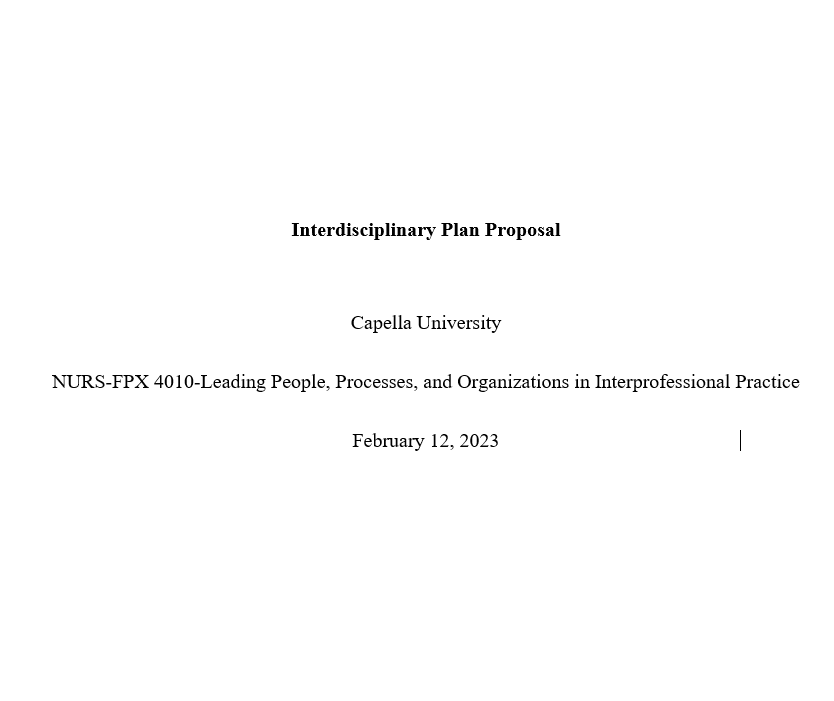NURS-FPX4010_N_Assessment 3-2 solution.docx
Interdisciplinary Plan Proposal
Capella University
NURS-FPX 4010-Leading People, Processes, and Organizations in Interprofessional Practice
February 12, 2023
Interdisciplinary Plan Proposal
Enhancing the quality and safety of patient care is a primary consideration for every healthcare provider. The process entails identifying barriers and enablers of effective patient care. Interdisciplinary collaboration is among the priorities that make the care team responsive to patients’ needs and expectations. The collaborative practices allow different healthcare professionals to share knowledge, skills, and experiences about strategies for enhancing the quality and safety of patient care.
This plan encourages the use of interdisciplinary rounds to improve communication and team functions necessary to identify risk factors associated with patient falls. The structured interventions enhance individual and collective commitment to reducing falls across the continuum.
Objectives
- To make the care team aware of hourly safety rounding as a process that incorporates behavioral and environmental components.
- To discuss the implications of interdisciplinary rounding on patients’ comfort and safety.
- To emphasize the need for the care team to play active roles in initiatives designed to prevent adverse such as patient falls and injuries.
- To encourage the care team to embrace interdisciplinary rounding as a means of enhancing patient recovery and reducing health care costs and length of hospital stay.
Questions and Predictions
- Will the care team recognize the impact of interdisciplinary rounding in reducing patient falls? The prediction is that nurses, physicians, clinical assistants, and others will embrace team-based values, behaviors, and attitudes (Schot et al., 2020). The care team will appreciate the need for collective commitment to identifying and intercepting risks associated with patient falls and injuries. The shared aspirations promote collective vigilance necessary to improve safety standards across the organization.
- Will interdisciplinary rounding create a transparent culture that encourages participation of the care team and patients? The prediction is that the care team will embrace calls for timely sharing of accurate and complete information on risks likely to trigger patient falls and injuries. This way, everyone involved in handling patients will use the various channels of communication to engage leaders and colleagues about scenarios that undermine the quality and safety of patient care (Rahmayanti et al., 2020).
- Will safety rounding encourage collaborative decision-making? The prediction is that working in multidisciplinary teams will make everyone aware of their roles in sharing accurate and complete information appropriate for monitoring safety and quality improvements. Health leaders such as the nurse manager will use their knowledge and experiences to create an ideal environment that accommodates shared interdisciplinary governance (Clausen et al., 2019). The aim is to communicate a sense of ownership and contribution towards enhancing the quality, safety, and cost of patient care.
Change Theories and Leadership Strategies to Address the Health Issue
Positive patient and organizational outcomes depend on effective use of a change theory. The framework guides health leaders and the care team on actions steps appropriate for producing the intended outcomes. The Plan-Do-Study-Act (PDSA) model is an evidence-based approach that supports interdisciplinary collaboration (McNicholas et al., 2019). The framework makes the care team responsive to calls for effective use of rounding to identify and intercept risks associated with patient falls and injuries.
With the PDSA model, the leader explains the issue, encourages shared aspirations, and encourages beliefs, attitudes, and behaviors that make interdisciplinary rounding a standard practice (McNicholas et al., 2019). The aim is to make everyone responsive to calls for collaborative practices as means of monitoring and controlling safety outcomes throughout the care process.
The transformational style is appropriate for introducing the change. The leader eliminates the status quo by allowing everyone to share suggestions about viability and improvements required to make interdisciplinary rounding effective for preventing patient falls. The people-centered approach to leadership helps the leader to initiate and maintain excellent interpersonal relations (Hussain et al., 2018). The leader encourages the need for shared decision-making. The leader also creates an open, transparent, and honest environment to ensure that everyone understands the purpose of interdisciplinary rounding in enhancing quality and safety of patient care.
May Clinic is an example of a facility that utilizes transformational leadership to make visible improvements in enhancing the quality, safety, and cost of patient care (Farrugia, 2020). The state of the art leadership allows patients and the care team to work together, shared knowledge, learn from each other, and drive strategies for optimizing care outcomes (Farrugia, 2020). Mayo Clinic allows physicians to bring the patient’s perspective to the decision-making process while the administrator leverages business acumen to achieve strategic priorities. Collaboration is a priority at Mayo Clinic to create an environment where everyone contributes their part and criticizes the work of the others.
The Interdisciplinary Plan
The plan is to initiate training and education on interdisciplinary collaboration. The nurse manager initiates conversations about the causes, consequences, and the need for timely interventions to reduce patient falls and injuries. The nurse manager facilitates access to resources such as interdisciplinary rounding checklists, pocket notes, and role play guides. The nurse manager will emphasize the need for nurses, physicians, and the rest of the care team to embrace values and behaviors appropriate for monitoring and controlling safety and quality issues within the clinical environment.
Collaboration Strategy
The interdisciplinary team has nurses, physicians, clinical assistants, a nurse manager, and an administrator. The group understands events within the clinical environment and improvements necessary to enhance the quality and safety of patient care. The roles at the bedside and organizational levels mean that the team understands the need for collaborative efforts that help prevent patient falls.
One strategy is encouraging everyone to embrace excellent communication to improve information flow across the continuum (Duffy et al., 2020). Effective interpersonal relations make it easier for healthcare professionals to share knowledge and experiences of patient falls. Another strategy is effective leadership to maintain an open, honest, and transparent environment (Doornebosch et al., 2022). The atmosphere allows individuals to share suggestions on improvements necessary to prevent patient falls.
Mayo Clinic is an example of a facility that successfully used interdisciplinary collaboration to reduce patient falls. The facility’s electronic board for communication enhanced knowledge sharing, which allow the care team to identify vulnerable patients and initiate prevention interventions.
Resources
The interdisciplinary plan requires the organization to allocate adequate resources that empower the team to respond positively to the calls for effective patient falls prevention. The training program will require leaders to ensure resources such as role play guides, interdisciplinary rounding checklists, and a case study are available to achieve the intended outcomes.
The interdisciplinary safety rounding checklists make the care team aware of the actions steps, behaviors, and attitudes relevant for enabling different healthcare professionals to remain vigilant across the care continuum. Similarly, case studies and notes supplied to the care team make everyone familiar with safety concerns within the clinical environment and collective efforts necessary to sustain quality and safety standards.
Table 1
Resources
| Resource | Description | Cost ($) |
| Interdisciplinary rounding checklists | The checklists make the audience familiar with steps for monitoring, identifying, and addressing risks that expose patients to falls and injuries. | 300 |
| Case study on interdisciplinary rounding to prevent patient falls | The Mayo Clinic multidisciplinary framework is ideal for guiding the care team to understand the relevance of interdisciplinary rounding in enhancing safety and quality of patient care. | 300 |
| Supply notes on interdisciplinary rounding | The notes highlights the relevance of interdisciplinary rounding and actions steps necessary to utilize the intervention effectively. | 300 |
| TOTAL | 900 |
References
Clausen, C., Emed, J., Frunchak, V., Purden, M., & Sol Bruno, F. (2019). Toward resilient nurse leaders: The leadership-in-action program in nursing (LEAP-IN). Nursing Leadership, 32(3), 40–56.
Doornebosch, A., Smaling, H., Achterberg, W. (2022). Interprofessional collaboration in long-term care and rehabilitation: A systematic review. Journal of the American Medical Directors Association, 23, 764-777. https://www.jamda.com/article/S1525-8610(21)01102-6/pdf
Duffy, J. R., Culp, S., Marchessault, P., & Olmsted, K. (2020). Longitudinal comparison of hospital nurses’ values, knowledge, and implementation of evidence-based practice. The Journal of Continuing Education in Nursing, 51(5), 209-214. https://pubmed.ncbi.nlm.nih.gov/32347957/
Hussain, S. T., Lei, S., Akram, T., Haider, M. J., Hussain, S. H., & Ali, M. (2018). Kurt Lewin’s change model: A critical review of the role of leadership and employee involvement in organizational change. Journal of Innovation and Knowledge, 3(3), 123-127. https://www.sciencedirect.com/science/article/pii/S2444569X16300087
McNicholas, C., Lennox, L., Woodcock, T., Bell, D., & Reed, J. E. (2019). Evolving quality improvement support strategies to improve plan–do–study–act cycle fidelity: A retrospective mixed-methods study. BMJ Quality & Safety, 28(5), 356–365. https://pubmed.ncbi.nlm.nih.gov/30886118/
Rahmayanti, E. I., Kadar, K. S., & Saleh, A. (2020). Readiness, barriers, and potential strength of nursing in implementing evidence-based practice. International Journal of Caring Sciences, 13(2), 1203-1211.
Schot, E., Tummers, L., & Noordegraaf, M. (2020). Working on working together: A systematic review on how healthcare professionals contribute to interprofessional collaboration. Journal of Interprofessional Care, 34(3), 332-342.

